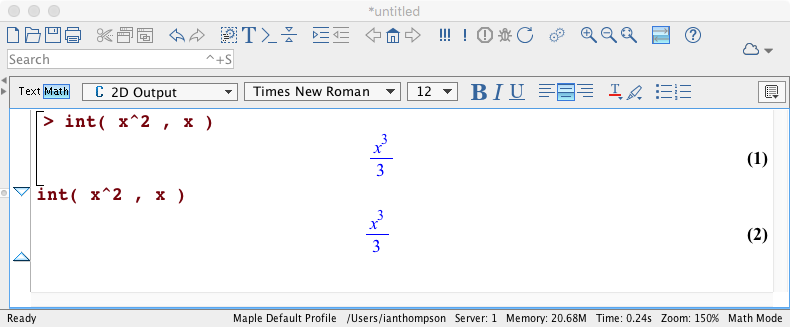How to permanently switch off 2-D Math Input

|
Probably the most frequently recurring question about Maple
is “How do I switch out of 2-D Math Input?” or some variant thereof.
Unfortunately, the terminology regarding Maple's interface is rather muddled, so to be 100% clear, input in 2-D
Math Notation looks like this:

whereas the same expression in Maple Notation would look like this:
1 / x^2 + 2Maple Notation is also sometimes called Maple Input, 1-D Math Notation and Text Mode. The last of these terms is ambiguous and should not be used, because Maple also has a mode for entering plain text (activated by pressing
 in the worksheet toolbar, or by choosing
from the
menu), which is something entirely different.
To avoid any confusion, this is referred to as ‘plain text mode’ below.
in the worksheet toolbar, or by choosing
from the
menu), which is something entirely different.
To avoid any confusion, this is referred to as ‘plain text mode’ below.
Here is the recipe for permanently switching to Maple Notation, from page 8 of Understanding Maple. It works in all recent versions, up to and including Maple 2017.
- On Linux or Windows, choose from the menu.
- On a Mac, go to the menu and select .
- Select the tab.
- From the menu next to , choose .
- Now select the tab.
- From the menu next to , select .
- While you are here, it's probably worth switching off the Default home page, so that a blank worksheet appears when Maple is started. To do this, choose from the menu next to .
- Finally, click , then quit and restart Maple.
Notes
- Maple will not revert to 2-D Math Input, but there is one caveat.
If you create a region where Maple expects plain text (e.g. by pressing the
 button
in the worksheet toolbar), or if the cursor somehow ends up outside the execution groups,
then the normal state of affairs can be restored by pressing
button
in the worksheet toolbar), or if the cursor somehow ends up outside the execution groups,
then the normal state of affairs can be restored by pressing
 , to insert
a new prompt (which may or may not start a new execution group, depending on the circumstances).
Other methods of switching back to Math Mode may activate 2-D Math Input.
, to insert
a new prompt (which may or may not start a new execution group, depending on the circumstances).
Other methods of switching back to Math Mode may activate 2-D Math Input.
- If you have saved any work in Document Mode, this will still be in Document Mode after applying the above settings, because Document Mode is a property of the file itself. You can get around this by opening a new worksheet in Worksheet Mode, copying and pasting the commands and closing the Document version.
More details
If you just wanted 2-D Math Input to go away, there is no need to read any further. However, to understand a bit more about what's going on here, it's important to know how to identify execution groups. You can do this by looking at the left of the Maple window. The black square brackets that appear here are called group ranges, and material enclosed in a group range is in an execution group. In the screenshot below, the first int command is inside an execution group, but the second is not.

|
The default input mode for new execution groups is set under , as described above. You can choose either Maple Notation or 2-D Math Notation. However, the default input mode for mathematics outside execution groups is always 2-D Math Notation (or at least I have never discovered a way to change this).
Now in Worksheet Mode, Maple creates execution groups automatically, but in Document Mode it does not. You can insert a group (in either mode) by pressing
 ,
or by using the menu.
In addition, there is an option under the tab
reached via
►
(Mac:
►
)
to always create new groups after executing.
This does work in Document Mode (though the first group must still be inserted manually),
but it has the annoying drawback that going back to an old group and executing by pressing
return inserts a new group, even if another already exists underneath.
This means that the process of correcting mistakes can cause a file to become cluttered with
empty groups. Therefore it's best to use Worksheet Mode,
and leave this option unticked.
,
or by using the menu.
In addition, there is an option under the tab
reached via
►
(Mac:
►
)
to always create new groups after executing.
This does work in Document Mode (though the first group must still be inserted manually),
but it has the annoying drawback that going back to an old group and executing by pressing
return inserts a new group, even if another already exists underneath.
This means that the process of correcting mistakes can cause a file to become cluttered with
empty groups. Therefore it's best to use Worksheet Mode,
and leave this option unticked.
Local methods
Various methods can be used to locally change the input mode. However, some of these behave differently depending on the current cursor location.- Pressing the button in the context bar near the top of the window, or choosing from the menu always activates 2-D Math Notation.
- Choosing from the menu will activate Maple Notation. It may or may not create a new execution group and/or a new prompt (>).
-
In an execution group, pressing the button in the context bar
will activate Maple Notation, except in a plain text region (created by pressing
 , or choosing
from the menu).
, or choosing
from the menu).
- The F5key is a toggle, whose effect is the same as pressing whichever of or is not currently active.
One last thing …
The drop-down menu immediately to the right of the and buttons in the context bar may appear to control the input mode, but it does not. It (locally) changes the font attributes, but it doesn't affect the way in which Maple interprets the input. An application of this might be writing a set of instructions for new Maple users. For example, in plain text mode, one might enter“The command for integration in Maple is int.”
and then change the appearance of ‘int’ to Maple Input. However, to avoid confusion, it's probably best to leave this menu alone.
| Back to main Understanding Maple page |